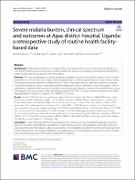| dc.contributor.author | Emmanuel, Ocen | |
| dc.contributor.author | Ronald, Opito | |
| dc.contributor.author | Crispus, Tegu | |
| dc.contributor.author | Alex, Oula | |
| dc.contributor.author | Peter, Olupot‑Olupot | |
| dc.date.accessioned | 2023-10-26T14:03:17Z | |
| dc.date.available | 2023-10-26T14:03:17Z | |
| dc.date.issued | 2023 | |
| dc.identifier.citation | Ocen et al (2023). Severe malaria burden, clinical spectrum and outcomes at Apac district hospital, Uganda: a retrospective study of routine health facility-based data | Malaria Journal. | en_US |
| dc.identifier.uri | https://ir.sun.ac.ug//handle/123456789/91 | |
| dc.description.abstract | Abstract
Background Most data describing severe malaria (SM) in sub‑Saharan Africa (SSA) are from research settings out
side disease endemic areas. Using routinely collected data from Apac District Hospital, this study aimed at determin
ing the burden and clinical spectrum of severe malaria.
Methods This was a retrospective study that reviewed all paediatric admission records for malaria in the 24 months
period from Jan 2019 to Dec 2020 at Apac District Hospital. Data on children aged 60 days to 12 years who at admis
sion tested positive for malaria and fulfilled the World Health Organization clinical criteria for surveillance of severe
malaria were abstracted using a customized proforma designed to capture variables on social demographic, clinical
presentation, treatment, and outcomes. In addition, the tool included laboratory variables for complete blood counts,
haemoglobin, and glucose levels. Data were analysed using STATA V15.0. The study had ethical approval from Mbale
Regional Referral Hospital REC, Approval No. MRRH‑REC 053/2019.
Results A total of 5631 admission records were retrieved for this study period. Of these, 3649 (64.8%) were malaria
admissions and 3422/3649 were children below 12years, with only 1864 (54.5%) of children having complete data.
Of the 1864 children, 745 (40.0%) fulfilled the severe malaria inclusion criteria. Of the 745 children, 51.4% (n = 381)
were males. The median age at admission was 31 months (IQR = 17–60). The most common clinical presentations
among children with severe malaria were fever 722 (97.3%), cough 478 (64.2%), and difficulty in breathing 122 (17.9%).
The median length of hospital stay was 2 (IQR; 2–4) days and 133 (17.9%) had prolonged hospital stay (> 4 days).
Factors independently associated with prolonged hospital stay were, presenting with difficulty in breathing, aOR 1.83
(95% CI 1.02–3.27, P = 0.042) and prostration aOR 8.47 (95% CI 1.94–36.99, P = 0.004). A majority of admitted children,
735 (98.7%) survived, while 10 (1.3%) died of SM.
Conclusion A high proportion (40.0%) of malaria admissions were due to SM. Prolonged Hospital stay was associ
ated with prostration and difficulty in breathing. Overall mortality was low, 1.3% compared to mortality in the previ
ously reported series. This study was able to use routinely collected data to describe the burden and clinical spectrum
of SM. Improvement in the quality of data from such settings would improve disease descriptions for policy, monitor
ing of epidemics, response to interventions and to inform research | en_US |
| dc.description.sponsorship | This publication was supported through MEPIE Study, part of the EDCTP2
programme supported by the European Union (Grant Number: TMA2016SF
1514‑MEPIE Study). The views and opinions of the authors expressed herein
do not necessarily state or reflect those of EDCTP. | en_US |
| dc.language.iso | en | en_US |
| dc.publisher | Malaria Journal | en_US |
| dc.subject | Child, Malaria, Hospitalization, Survivors | en_US |
| dc.title | Severe malaria burden, clinical spectrum and outcomes at Apac district hospital, Uganda | en_US |
| dc.title.alternative | a retrospective study of routine health facility based data | en_US |
| dc.type | Article | en_US |

